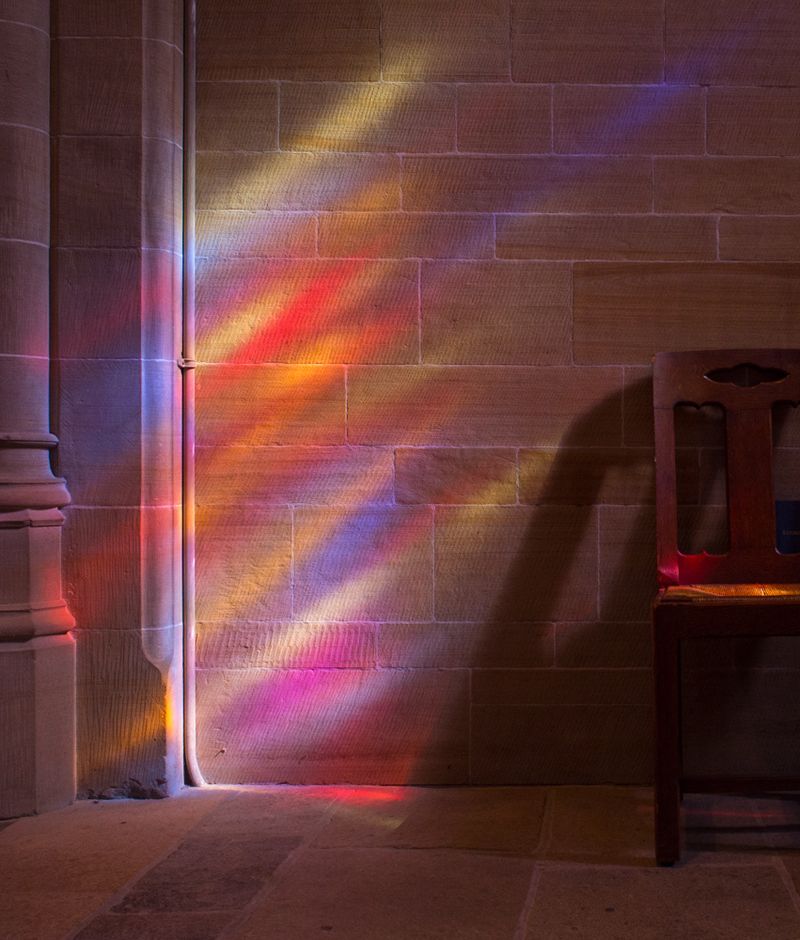 Interior, Bryn Athyn Cathedral
Interior, Bryn Athyn Cathedral
A Review of the Olympus E-P5 From a Street and Travel Photographer’s Perspective
Reviewed by Gordon Lewis
Part 2—User Report and Conclusions
In the first half of this review I described my first impressions of the Olympus Pen E-P5 and what it was like to set it up and get ready to shoot. This part will describe what it’s like to actually shoot with it. My bias is toward street and travel photography. Because of the E-P5’s compact size, interchangeable lenses, and relatively large sensor, street and travel are sure to be a natural market for this sort of camera.
Handling
The Olympus E-P5 is one of those cameras that, as the saying goes, "falls naturally to hand." It feels neither too light nor too heavy, is well-balanced, and the controls you need are where you need them. I most often shoot in aperture preferred mode, and it felt perfectly natural to adjust the aperture with the rear dial and exposure compensation with the front. I was able to carry the E-P5 on my wrist or in a small shoulder bag for hours at a time without getting fatigued, which is a valuable quality for a street and travel camera.
 This is one of the first shots I took with the E-P5 and 17mm ƒ/1.8. I
intended it as something of a torture test. The bridge was backlit, with
the sun slightly veiled by clouds. The water and trees were dark. Could
this camera and lens combo avoid over-exposing the sky, not cause flare
in the shadows, and resolve fine detail? As you can see, the answer is
yes. I did have to clean up some chromatic abberation between the bridge
and sky, but that was about it.
This is one of the first shots I took with the E-P5 and 17mm ƒ/1.8. I
intended it as something of a torture test. The bridge was backlit, with
the sun slightly veiled by clouds. The water and trees were dark. Could
this camera and lens combo avoid over-exposing the sky, not cause flare
in the shadows, and resolve fine detail? As you can see, the answer is
yes. I did have to clean up some chromatic abberation between the bridge
and sky, but that was about it.
I'm not the only person who thought so. A photo enthusiast friend of mine saw me using it at a backyard barbeque and asked if he could try it out. I literally just handed it over. After a few shots he exclaimed, "This thing is sweet! I love how it feels." Handling aside, he was most impressed with the fact that although it was early evening, the E-P5 was able to focus accurately and deliver well-exposed, razor sharp, available light photos at an average shutter speed of 1/20 second at ISO 1600. He was so impressed that he plans to buy an E-P5 to take with him on his honeymoon to Jamaica.
But I digress. Another source of joy in handling is the shutter release. The button is generously sized, and with an action that's just right: firm and quick, yet not a hair trigger, and with a soft yet solid click. Another sound you’ll notice when you press the shutter button is the soft whir of the in-body image stabilization (IBIS). My subjects weren't able to hear it though, even when I was only a few feet away.
As great as the E-P5 feels in general, it isn't perfect. The bottom plate has a relatively sharp radius, which makes the camera uncomfortable to hold in the right hand for extended periods, especially if you’re using a wrist strap. This is aggravated by the fact that the front gripping surface is so small you often have to wrap your two lower fingers under the camera to support it.
Shooting
First, I have to say how surprised and delighted I was with how quickly the E-P5 focused in bright-to-medium light. It seemed, for all practical purposes, instantaneous. Even when I aimed it at someone walking or even running towards me, the E-P5 nailed the focus in a fraction of a second.
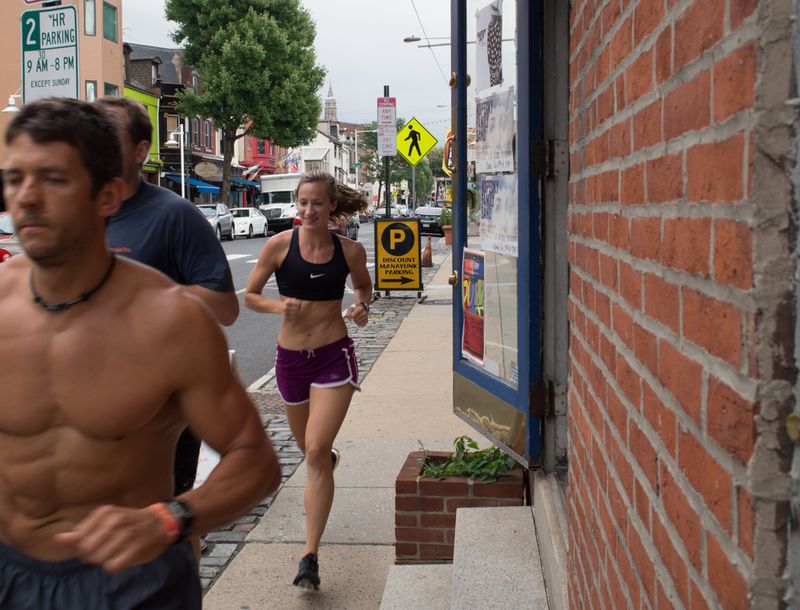 This isn’t a great shot in and of itself. What’s impressive in this case
is that when I noticed these people running towards me, I literally
just raised the E-P5 to my eye and snapped the shutter. It locked focus
instantly and accurately.
This isn’t a great shot in and of itself. What’s impressive in this case
is that when I noticed these people running towards me, I literally
just raised the E-P5 to my eye and snapped the shutter. It locked focus
instantly and accurately.
I didn't have time to try it in follow-focus mode with moving subjects, but based on my experience with other mirrorless cameras, that is not likely to be its strength. The same is true in low light, especially at distances beyond the range of the E-P5's AF assist light. The focus accuracy becomes hit or miss. Fortunately, the VF-4 viewfinder had enough resolution that I could often tell if the focus was off and, if time permitted, focus manually.
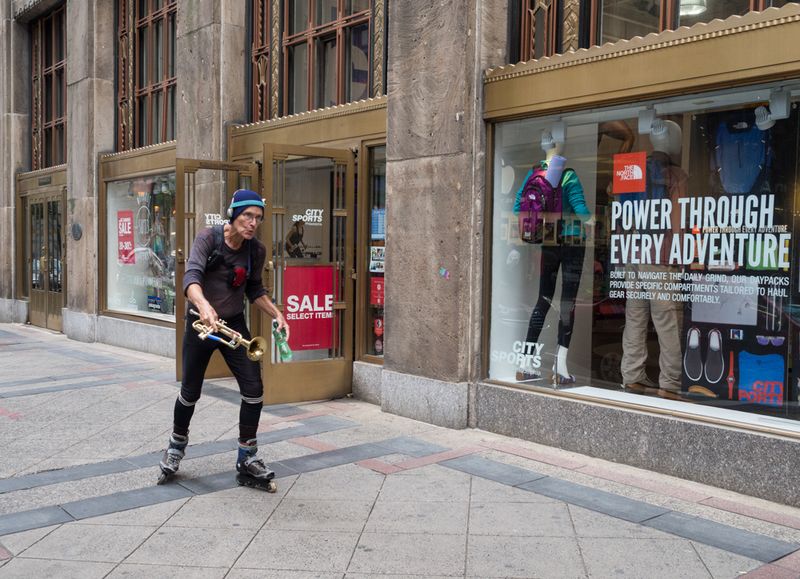 Here's another example of where the E-P5 was able to focus as soon as I
raised the camera to my eye and released the shutter. The fact that his
posture mirrors that of mannekin is
pure luck and coincidence.
Here's another example of where the E-P5 was able to focus as soon as I
raised the camera to my eye and released the shutter. The fact that his
posture mirrors that of mannekin is
pure luck and coincidence.
As I mentioned before, I preferred to use the 10X magnification feature when focusing manually or to simply zone focus. When you're using a 17mm lens set to ƒ/5.6 or ƒ/8, you've got a lot of depth-of-field and margin for error. The E-P5 also has a "focus peaking" feature that overlays a white outline over areas that are within the plane of focus. The lines were difficult to see clearly and their accuracy seemed too subjective at times, so I didn't use it much. It could be more useful with manual-focus-only lenses, though.
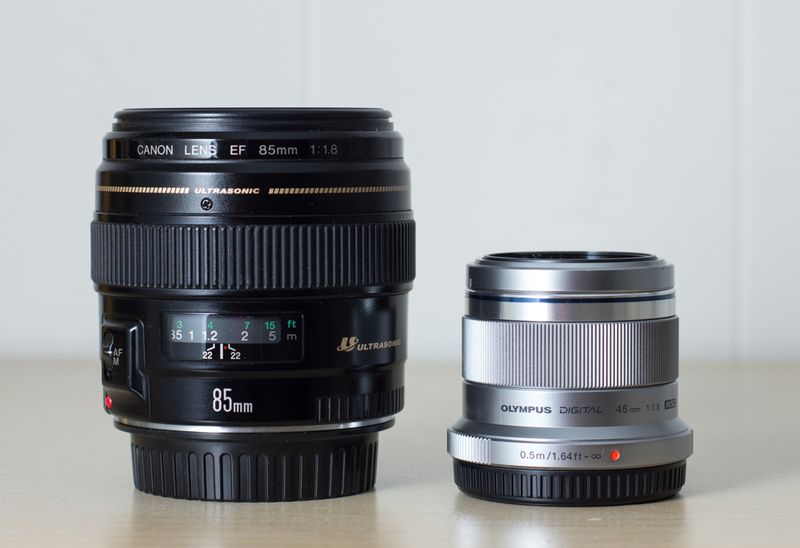 Big win for Micro 4/3 in general: The comparison with my Canon 85mm ƒ/1.8 EF is particularly telling. It represents how big the typical full-frame, medium-tele, AF lens is these days—without a hood! The Olympus 45mm ƒ/1.8 m.Zuiko captures roughly the same angle of view and has the same aperture but is a lot smaller and lighter.
Big win for Micro 4/3 in general: The comparison with my Canon 85mm ƒ/1.8 EF is particularly telling. It represents how big the typical full-frame, medium-tele, AF lens is these days—without a hood! The Olympus 45mm ƒ/1.8 m.Zuiko captures roughly the same angle of view and has the same aperture but is a lot smaller and lighter.
Another thing I discovered is that the E-P5's auto white balance had trouble with tungsten and fluorescent lighting. I had to change the white balance to tungsten or fluorescent to get a reasonably neutral balance on screen. Unlike DSLRS, live view-only cameras such as the E-P5 give a close approximation of the white balance and exposure you will see in a JPEG. If you're shooting RAW you can simply correct in post. If you're shooting JPEGs (the E-P5's JPEGS are excellent, by the way) you need to correct the white balance before you shoot.
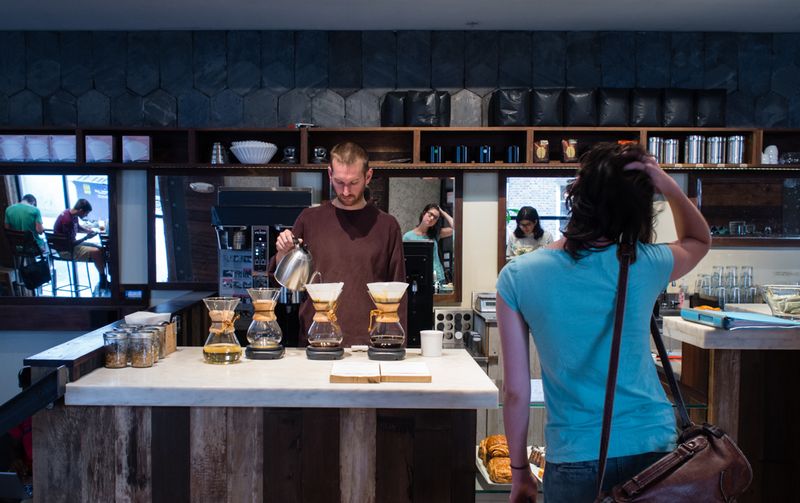 Here's an example of how the E-P5 performs in indoor tungsten lighting. I
had to cool down the white balance and adjust the framing a bit;
otherwise, this shot is pretty much as-is.
Here's an example of how the E-P5 performs in indoor tungsten lighting. I
had to cool down the white balance and adjust the framing a bit;
otherwise, this shot is pretty much as-is.
When it came to framing shots, I noticed that when the IBIS kicks in it stablizes the image so well that minor framing adjustments seem to have no effect. This is barely noticeable when you're doing grab shots. When you're trying to frame precisely it can take a second or two more time to get it right.
Wi-Fi and Video
I hope you weren’t waiting for this, because I didn't try either one out. I can tell you, however, that I've done several tech guides for Canon on how to use their Wi-Fi feature and Olympus's version is designed to be a lot more user-friendly and automated. It basically allows you to use your cellphone or iPad as a remote display and controller for the camera. Instead of entering a series of network ID numbers, you link you mobile device to the E-P5 by scanning a QR code that appears on the E-P5's LCD. What you gain in simplicity, however, you lose in flexibility. The Olympus Wi-Fi control function only works when the camera is set to its "iAuto" mode and your ability to adjust camera functions is limited.
Image Quality
I'm still using Adobe Lightroom 4 to process my images. Because LR4 won't read E-P5 RAW files (LR5 will), I had to first convert them to DNG with the latest version of Adobe Raw Converter, then import them into LR4. The effort was worth it. Practically every file looked correctly exposed from the start. Blown highlights were rare. Shadows were deep but detailed. I’ll let you judge the overall color pallette and tonality yourself from the sample images I've provided. I would personally characterized it as subtle yet distinctive and very flattering to skin tones.
 Here's another test of the E-P5's exposure metering and dynamic range,
which it once again passed with flying colors. I did minimal
post-processing, yet there is detail in the brightest highlights and
deepest shadows.
Here's another test of the E-P5's exposure metering and dynamic range,
which it once again passed with flying colors. I did minimal
post-processing, yet there is detail in the brightest highlights and
deepest shadows.
As for how the E-P5 files compared to those of my two other cameras, a Nikon V1 and Canon EOS 60D, they were noticeably more sharp and had better microcontrast and color clarity than images from the Nikon V1. They also required less post-processing and were easier to adjust. This wasn't a dramatic difference, mind you; just enough to be noticeable.
 I took this shot in the evening, with the only light from a patio light
15 feet away and from the room behind my friend Dan. He looked like a
silhouette to the naked eye. Here's what he looked like at an exposure 1/20
second at ISO 1600.
I took this shot in the evening, with the only light from a patio light
15 feet away and from the room behind my friend Dan. He looked like a
silhouette to the naked eye. Here's what he looked like at an exposure 1/20
second at ISO 1600.
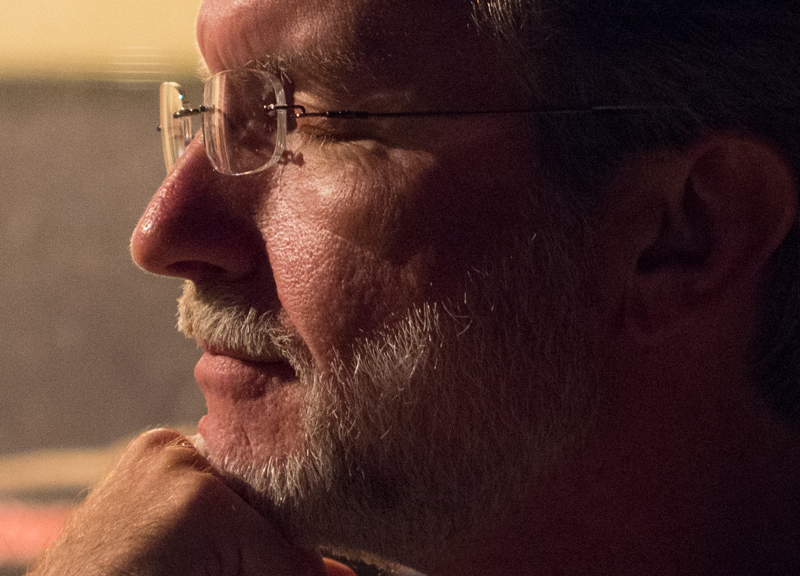 Here's the same image at 100%. Not bad for a handheld shot at 1/20 second!
Here's the same image at 100%. Not bad for a handheld shot at 1/20 second!
When I compared the E-P5 files to similar shots from my EOS 60D, it was a lot harder to say which was better overall. Image stabilization meant the E-P5 files had less blur from camera shake, but the 60D files had more consistently sharp focus in low light. ISO-for-ISO, 60D files looked slightly smoother, while E-P5 files had a bit more grit and "character." The 60D was better at ISOs above 1600, but if you’re using fast lenses and image stabilization there’s not much need to shoot above ISO 1600 anyway. Suffice it to say that your technical abilities are more likely to be the limiting factor with the E-P5 than the camera itself. Its capabilities well exceed what you'd be able to see or display in a web-sized JPEG. Sharp lenses and good technique can produce excellent 16x20-inch prints with ease.
Summary
I would have no second thoughts about tossing the Olympus E-P5 into my shoulder bag and taking it on a trip or out for a few hours of street shooting. It's small enough to be inconspicuous, light enough to be comfortably carried all day, and capable of producing amazingly high-quality photos.
If I were in the market to buy one though, I'd have to look at similarly spec'd alternatives, which are hard to dismiss. The Fuji E-X1, for example, is of similar size and weight, cost $200 less for the body, and has an electronic viewfinder built-in. The E-P5's sibling, the OM-D E-M5, also has a built-in viewfinder and costs $100 less for the body. The Sony NEX-6 body costs $350 less and also has a built-in viewfinder. A built-in viewfinder frees up the hot shoe for other uses, so the difference isn't price alone.
These prices are over and above the premium you pay for mirrorless ILCs in general. A Canon SL1 with an 18–55mm ƒ/3.5-5.6 IS lens would cost roughly $250 less than the Olympus E-P5 body alone. The price differences in Europe, Asia, and Australia could be even higher. None of this is to imply that price is the only consideration or that the Olympus E-P5 may not be worth it to you. All I'm saying is that it will be interesting to see how well it does given the variety of attractive alternatives. I would much rather have an abundance of great choices rather than fewer.
Gordon
Olympus 17mm ƒ/1.8 lens at B&H Photo (silver; black is available for pre-order)
Olympus 17mm lens at Amazon (silver is in stock, black is available for pre-order; just click on the color you want).
Philadelphia family man Gordon Lewis, who also writes the photo blog Shutterfinger, has many published articles in photo magazines to his credit. His other interests include guitar, writing, escrima, and martial arts (kali and tai chi). In a former life he was a writer of television sitcoms.
©2013 by Gordon Lewis, all rights reserved
Links in this post may be to our affiliates; sales through affiliate links may benefit this site.
(To see all the comments, click on the "Comments" link below.)
Featured Comments from:
No featured comments yet—please check back soon!



